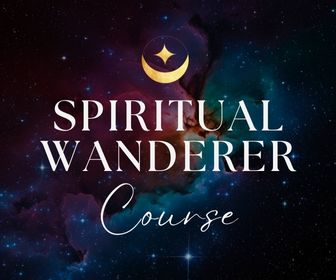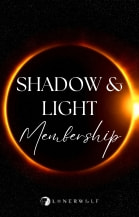Tasha from the USA recently asked us:
Could you share some tips for letting go of your fears? Even the really scary ones.
The first thing to understand is that fear is a natural and necessary quality. It’s an instinctive intelligence that contributes to our physical preservation. We all have precious lives to protect and if we aren’t afraid of falling off bridges, being hit by cars, or being eaten by hungry lions, we wouldn’t have been able to evolve and survive in the first place.
We all know that a courageous person is someone who still feels fear but chooses to act anyway. But fear can work in two way: it can be physically life-threatening or mentally constructed. When our fears are mentally constructed then they become abnormal.

Spiritual Wanderer Course:
Find your deepest path and purpose in life as a spiritual wanderer. In this immersive course, you get 3+ hours of content, workbooks, meditations, a premium test, and more!
Fear is a tool that can be harnessed skillfully only by those who have found mastery within themselves. It’s very easy for fear to become abnormal and mentally constructed in our society, so let’s have a closer look at how to deal with it.
How Fear Works
I like to think of fear as a blockage within us; a heavy energy that we create which prevents us from experiencing a harmonious state of being.
For example, if you are in a conversation and someone begins shouting at you, criticizing you, or talking about a topic you find uncomfortable, you immediately feel a flush of blood run to your face, an increased heart rate and a desire to retreat from the situation. Because social etiquette dictates that you can’t physically run away from it (although you could if you wanted to), you instead decide to mentally and emotionally withdraw from such uncomfortable experiences.
We get the exact same response when we are physically threatened, except when we are confronted with another’s hostility or intimidating behavior we protect our mental sense of identity; our self-worth, instead of our bodies. To differing extents we are all hyper-sensitive to others judgments of us, bad memories and traumatic past experiences, so our tendency is to lock away these painful parts of ourselves from being hurt again.
It is through this “locking away” process that we end up with a severely fragmented self. When we lock away enough painful memories and sensations, we quickly become so out of balance that even the slightest fear can tip us over the edge; a pimple on our face, a stutter in our voice, a bad joke made in front of our co-workers.
Most of our daily energy is consumed in the constant attempt to keep up our inner barriers. In the process we continue to lock away our illnesses deep inside without trying to cure them. It’s amazing the lengths we’ll go to protect these barriers. We will attempt to avoid the unknown, any type of change, and we will try to control everything around us to avoid dealing with our deeper issues. Finally, if someone else comes and criticizes us, we immediately become defensive and try to desperately protect or defend ourselves, trying to destroy and/or escape anyone and everything that reminds us of our deep-seated unresolved biggest fears.
This is because fear is its own enemy; it doesn’t want to feel itself because it is afraid of itself. Therefore, to truly liberate ourselves, break down the barriers within us that keep us fragmented, and truly grow as people, we must first be willing to feel and deal with these fears.
Becoming Aware of Your Fear
Our natural instinct is to want to create a life that doesn’t trigger any of our fears. Because of this, many of us live bland, predictable lives where we continue to avoid any change that might bring about these feelings.
The more afraid you are, the greater you tend to dislike change of any kind. But change is necessary in order for us to release our fears. Change is immensely useful as it provides the space for our fears to surface. For that reason, it is extremely important that we welcome it into our lives.
Would you like to know how to do this?
The first step is to stop closing yourself off. This means that it is important for you to stop protecting yourself from what you fear, allowing it to surface instead so that you can become aware of it. For example, you might fear experiencing moments of awkwardness, pain, shame, guilt, horror, angst, but whatever the issue is, a fear is basically a sensitive part within you that you don’t want to expose — and yet exposure is what hardens you and liberates you.
Yes, at first it can be shocking, even terrifying to feel our fear arise because we are directing all of our conscious attention towards it. At first allowing your fears to arise might give rise to a notably altered state of consciousness where life doesn’t look beautiful anymore, the world is hazy, people are blurry and there is an underlying sensation of panic.
But by allowing this heavy energy within us to come out, we are also creating the freedom to let it go. Fear is a powerful thing. But by developing the courage and intent to face our fears, we now have the power to choose what to do with them.
Letting Go of Fear
A person who has fears and makes the choice of avoiding them is someone who lives life constantly resisting.
When we constantly resist and fight against life, our pasts become constant replays and recollections of disturbing moments, our presents are filled with dread and the tension of always being on guard, and our thoughts of the future are filled with anxiety.
In truth, the more we avoid our fears, the more they grow in magnitude so that eventually they become so large that we feel hopeless to ever be “free” of them.
Perhaps you have tried reasoning yourself out of fear — but this, as you have most likely found, is almost always futile. Perhaps you might have adopted a variety of avoidance tactics that keep the fear just at bay — but this is only another short-term solution. Eventually after going over and under your fears with no avail, you soon discover that the only way to truly overcome them is to walk right into them.
Would you like to save this?
Your information will never be shared.
The secret to letting go of any fear is doing the opposite of what you instinctively desire to do. Instead of running away from the tornado, you must stop, see the tornado coming towards you, and simply stand there. Yes, you might be sucked up by the tornado and tossed around a bit, but eventually you will make it to the eye of the tornado, and stand freely in the core of your being.
This core of your being is also known as your “center,” “awareness” or “conscious space.” This is a place of limitless silence and peace. So the moment you feel any fear – let go – let yourself experience the tornado without running, repressing, hiding or smothering. By choosing to let go, by choosing “non-resistance” you still continue to experience the fear, but you will watch it from a distance. It is happening, but it is not “you.”
The important thing here is to refrain from any form of resistance – even the judgment of how well you’re doing at letting go can become a form of resistance. Thoughts like, “I shouldn’t be feeling fear anymore” are still forms of resistance. Don’t fight with it, don’t try to change it, and don’t judge it. You might feel the suction of the tornado pulling at you, but continue treating it with the same willingness to let go:
Take a depth breath, release, relax, exhale and observe what is happening inside of you.
Three paths to inner transformation – here’s how I can help you go deeper:
1. The Spiritual Wanderer Course: Are you feeling lost, adrift, and unsure of your life's purpose? Gain clarity, focus, and direction on your inner path by uncovering the five archetypes of awakening within you. Learn how to navigate the highs and lows of your inner journey and chart your unique path with 3+ hours of audio-visual content, workbooks, meditations, and a premium test.
2. Shadow & Light Membership: Do you crave consistent support on your spiritual quest? Receive weekly intuitive guidance and learn to embrace your whole self, including your shadow side. Cultivate deeper self-love with our affordable, personalized support.
3. Spiritual Awakening Bundle: Ready to embark on a profound soul-searching adventure? Dive into our collection of essential transformative resources! Explore five illuminating eBooks and seven in-depth journals, plus unlock two special bonuses to empower your spiritual growth.








Considering there are a lot of articles online when you search “How to overcome your fears,” or “How to let go of your fears,” I rather not repeat them. Instead, I’ll just comment my perspective on a specific set of fears here. If anything, people have to let go of the idea that social norms are rules that they have to follow no matter what, even if such social norms are unfair, stupid, or even dangerous. Something that is a social norm is not necessarily what is ethical, what is intelligent to do, or what is safest to do. I’m not saying to ignore all social norms. I’m sure doing something like keeping up an expected sense of hygiene and saying your please and thank yous is fine, but we all know not all social norms and social expectations are innocent like that. It doesn’t matter if it’s their “culture,” “their background,” or “their way of doing things.” What is abusive is abusive. What is discriminatory is discriminatory. This is not to say we can’t accept harmless differences, but if it causes active harm, then it doesn’t matter. I heard there was this tribal culture where they think if someone had twins or if the baby was disabled, then they’re demonic, and should be killed. I’m not going to say “it’s just their culture,” in this situation. Though if something harmless was involved, like a simple difference in appearance, an interesting festival, different languages, or different signs of politeness, that doesn’t really matter. But a crime is a crime, no matter where you are in the world.
Unfortunate that the world is full of so many corrupt judges. I suppose we “redefine” words then, so we’re slipping on all of the letters instead of having sure footing. Karma still exists. The laws of the Universe haven’t changed.
I think the person in that scenario would have to learn how to accept the reality that that will happen to them and eventually find peace with it if that was their goal. It’s not about the fears going away, but about overcoming them so you don’t have to feel boxed in or immobilized by it.
So what if someone is deaf. And their fears are public humiliation because it happens daily and will never go away when facing the public??? How can you let go when embarrassment is the biggest fear and it’s permanent? Just a simple misunderstanding can cause a altercation without even having knowledge of why. Those are fears that will happen and never go away.
Ah yes, because being disabled is innately shameful, and others not liking it means it’s a bad thing. What other people’s opinions are is not always correct. Just because others care, doesn’t mean you have to care. Also someone having a disability like deafness doesn’t mean they’re powerless, defenseless, or weak. It doesn’t mean their life is going to be always filled with misery. It’s an insult to see those with disabilities as someone to pity, not someone who’s just a normal person like you, despite their differences. Look up “inspiration p0rn,” or the term describing how disability is meant to be “inspirational,” in a way that is patronizing. That is, you congratulate people for even doing minor things they’re capable of doing, and one disability doesn’t mean you’re disabled in all ways. For example, if you’re deaf, you’re likely not also blind, capable of walking, capable of intelligence, of writing, and of communicating in your own way through sign language, but then people do this thing where they congratulate you for even having any minor independence in a way that is insulting. Look up “The infantilization of disability,” “Disability myths/misconceptions,” “Disability stereotypes,” and “Ableism signs,” if you want more information.
Superhuman: The Invisible Made Visible
we have more than 5 senses.
disability is an improper label.
much like pathological demand avoidance.
allow me to offer a reframe:
differabled.
pervasive drive for autonomy.
❤️
Jump in a tornado? No. Why give up resisting? Isn’t “fight or flight” part of survival. We can’t control other people or the unknown but we do have the power with our reaction. Action+reaction=consequence.
It’s a metaphor, you idiot. It’s not literal. Also, why is jumping in a tornado not fight or flight? You think you can fight if you don’t directly confront something? I think what you want here is flight, because you rather run away from the tornado, hahaha.
Fight or flight is a part of survival just like freeze and fawn.
the key is to learn how to deactivate your nervous system. Then you can make a conscious choice to respond rather than react.
I don’t think it’s nice to call people idiots. But I agree that I’d only get so close to a tornado. Depending on the circumstances.
Hi Gitte, I just read this article and love it. I still have a lot of fears to deal with, but I had this exact fear that you had and got over it in a similar way. I was so terrified to be alone that I had my mom sleep with me. Eventually I began sleeping badly as my mom would dream and wake me up talking and moving in her sleep. I realized that I wanted the bed to myself and that it was absurd to lose sleep over trying to escape from a non existent threat. This fear dissolved overnight, and now I can chill in my house alone comfortably and sleep in my bed alone with the lights off. I guess sometimes we need a breaking point to recover.
“When our fears are mentally constructed then they become abnormal.” Please be cautious about such labeling. To some people, their fears appear absolutely “normal” because this is their reality of perception (just as labeling them “abnormal” is yet another reality perception). Such labeling may also subconsciously deepen a belief paradigm that says: “there is something wrong with me,” “I am so screwed-up” and many possible others.
That’s why I go on to say in the rest of the article: “Thoughts like, “I shouldn’t be feeling fear anymore” are still forms of resistance. Don’t fight with it, don’t try to change it, and don’t judge it.”
If a person is interested in overcoming their fears, as they would be if they’re reading this article: they must have become aware of something within themselves (a fear) that they perceive other people don’t have, and therefore feel its ‘abnormal’.
Then perhaps that paragraph and the post itself would have been just fine without such a sentence.
The sentence is necessary to distinguish between physical fears (such as those that threaten our lives) and mental ones, which turn into neurosis (and consequent abnormality).
I came across your site, as with the current world situation, and awakening it has be come clear that really have to let go of fear, but it feels like I have so many. I am afraid if the tyrannical government, forced medical treatments, my kids being hurt, starvation, finical disaster, death. How does one let go of these fears? Any insight would be helpful.
Thank you
The best I can offer is make peace with them. Fighting them, doesn’t work. What you resist persists. Running also no good. Shutting down. Nope. Freezing. The worst agony of watching everything you long for passing in front of you and you cannot speak.
deactivate your nervous system (grounding, self care & love, nature, safety) and then you can see from additional perspectives.
letting go is always almost the hardest thing to do but you give an advice here that I absolutely need and I feel if I do this 100% I can finally face my fears. Running away or keeping them at bay as I’ve learnt is the worst thing you can do because they just catch up and bite you in the end – this time it’s even harder to let go of this fear. Thank you so much for this – it has made me aware of something I always knew. Being a cowardice is the worst thing you can do. Courage up even just for a moment is all you need.
what if your fear is of someone leaving?? Even the slightest change or event in your relationship could cause that fear to come back. Feels like a never ending circle.
I think every true fear has its roots somewhere in your life, the fear of height(like mine from my 2 schoolyear) or the fear of being left…
If you find your inner peace with the situation that caused the fear, you will get past it and you’ll maybe learn to enjoy the things in life which you once feared.
If you ask yourself, you’ll always get an answer….
Make peace with what comes up for “what’s the worst that can happen?”
you’ll be alone?
we are all alone in some ways.
opportunity to get to know yourself.